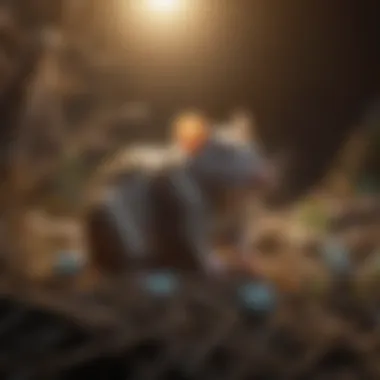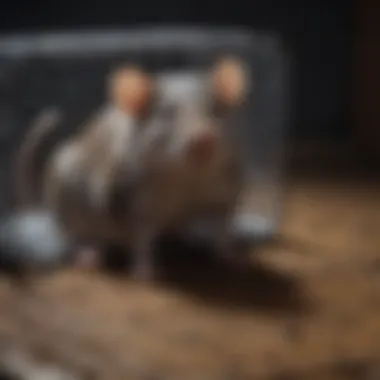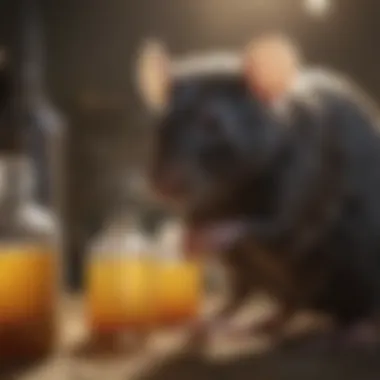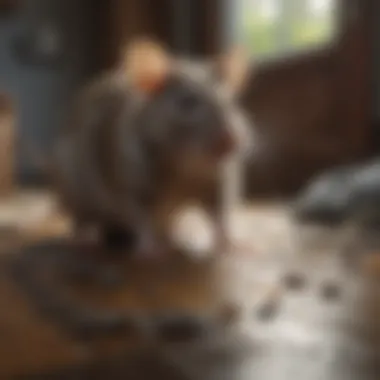Effective Methods for Eliminating Rat Nests


Intro
Rats are more than just pests; they can pose serious health risks and cause significant property damage. Understanding how to effectively deal with rat nests is crucial for homeowners and housewives. This article will guide you through the essential steps to identify, eliminate, and prevent rat nests in and around your home. By utilizing effective methods, you can protect your living space and maintain a safe environment.
Pest Identification
Recognizing the signs of a rat infestation is the first step in managing the problem.
Detailed Descriptions of Common Pests
The two most common types of rats in urban areas are the Norway rat and the roof rat. The Norway rat is generally brown, with robust bodies and shorter tails compared to their body length. They tend to live in burrows and are often found in basements and sewers. On the other hand, the roof rat has a slender body, is black or gray in color, and prefers to nest in higher locations like attics or trees.
Signs and Symptoms of Infestations
Identifying a rat nest requires keen observation. Here are some key indicators that you have an infestation:
- Droppings: Rat droppings are about the size of a raisin and can be found near food sources or nesting areas.
- Gnaw marks: Look for signs of gnawing on wires, furniture, or food packaging.
- Nesting materials: Rats will often gather insulation, paper, or cloth to create nests.
- Noises: You may hear scurrying sounds, particularly at night when rats are most active.
"Identifying these signs early can significantly increase the chances of effectively managing a rat infestation."
Prevention Strategies
Once you have identified the presence of rats, it’s essential to explore prevention tactics to avoid future infestations.
Home Maintenance Tips for Pest Prevention
Maintaining a clean and secure home is the first line of defense against rats. Here are some practices to consider:
- Seal Entrances: Close off holes or cracks in walls, floors, and around pipes with materials like steel wool or caulking.
- Secure Food Sources: Store food in airtight containers and clean up spills promptly.
- Maintain a Clean Environment: Regularly dispose of trash and clutter to remove hiding places.
Natural Deterrents and Barriers
Using natural deterrents can be effective in keeping rats at bay. Consider these options:
- Essential Oils: Oils like peppermint may help repel rats. A few drops on a cotton ball placed near entry points can be beneficial.
- Cats: Having a cat can naturally deter rodents due to their predatory nature.
Treatment Options
If an infestation has already occurred, addressing the issue promptly is vital.
Overview of Chemical vs. Natural Treatments
When it comes to treatment options, you generally have two paths: chemical solutions and natural methods. Chemical options include rodenticides that can be effective but carry risks to pets and children. Natural treatments, on the other hand, involve non-toxic methods focusing on traps and barriers.
Step-by-Step Guides for DIY Treatments
Here is a basic guide for implementing a DIY method using traps:
- Choose the Right Trap: Select from snap traps, electric traps, or humane traps depending on personal preferences.
- Placement: Set traps in areas where droppings or signs were found. Use bait like peanut butter for best results.
- Check Regularly: Inspect traps daily to remove caught rats and reset them as necessary.
Understanding Rat Behavior and Nesting Habits
Understanding rat behavior and nesting habits is crucial for effectively managing a rat infestation. Rats are aware creatures with instincts shaped by their environment. Their behavior directly impacts the location and construction of their nests. By grasping their nesting habits, homeowners can better develop strategies to eliminate them.
Common Species of Rats
The two most common species of rats that infest homes are the Norway rat and the roof rat. The Norway rat is larger, usually brown to gray in color, and tends to burrow underground. Conversely, the roof rat is smaller, has a sleek body, and prefers to nest in higher locations like attics and trees. Knowing which species is present can help in adopting the proper removal techniques.
Typical Nests Locations
Rats prefer specific locations for nesting. In residential areas, commonly frequented sites include:
- Wall voids: Gaps in walls where insulation or wiring exists.
- Basements and crawl spaces: Dark, sheltered areas provide ideal conditions for nesting.
- Attics: Roof rats often inhabit this area due to the higher vantage point.
- Outdoor structures: Sheds or garages can also be attractive nesting sites. By inspecting these locations, homeowners can locate nests more effectively.
Indicators of Rat Infestation


Recognizing signs of rat activity is essential to prompt an effective response. Key indicators include:
- Droppings: Rat feces, which can be dark and pellet-shaped, often found near nesting sites.
- Gnaw marks: Chewed items around the house, such as electrical wires and food packages.
- Footprints: Dusty areas might reveal small tracks left by rats.
- Nests: Shredded paper, fabric, or insulation may indicate nearby nests. Monitoring these signs helps homeowners confirm an infestation, allowing for timely management action.
"Understanding the behaviors and preferences of rats is the first step in effective pest management."
By identifying the species, typical nesting locations, and key indicators of an infestation, readers will gain a well-rounded understanding of how to approach rat nest elimination.
Preparing for Nest Removal
Before embarking on the removal of rat nests, it is essential to prepare properly. Taking the time to assess the situation can significantly affect the success of your efforts and reduce potential health risks. Knowing what to expect and having the right tools at hand supports an efficient and safe removal process.
Assessing the Infestation
Assessing the infestation is a critical first step. It involves observing the signs of rat activity and understanding the extent of the problem. Common indicators include droppings, gnaw marks, and sightings of the rodents themselves. Locating these signs helps you determine how many rats might be present and the best approach for their removal.
A thorough inspection of your property is necessary. Look in areas where food is stored, in attics, basements, and even behind appliances. Keep an eye on possible entry points, as knowing where the rats are coming in is key to preventing another infestation.
Gathering Necessary Tools and Materials
Having the right tools and materials ready can streamline the nest removal process. Below is a breakdown of essential items you should gather before you start.
Gloves and Protective Gear
Wearing gloves and protective gear is vital when dealing with rat nests. Gloves protect your hands from direct contact with droppings, urine, and parasites that rats may carry. The key characteristic of durable gloves, such as rubber or disposable latex, is their resistance to punctures and tears. This choice is beneficial because it ensures better handling of materials without risk of contamination.
The unique feature of thicker gloves is their ability to prevent any bites or scratches during the removal process. However, one should note that gloves alone are not sufficient protection; a proper face mask or goggles may also be necessary to avoid inhaling harmful particles.
Traps and Baits
Traps and baits play a significant role in the elimination of rat nests. These tools can effectively catch rats and help reduce their population. Snap traps and live catch traps are two popular options. Their key characteristic is efficiency in quickly capturing rodents without requiring extensive setup.
The unique feature of traps is their ability to be reused or set once. Still, one must consider the placement and bait used, as these elements affect their success rate. Baits can lure rats, but improper use may also attract non-target animals, creating more problems.
Disinfectants
Disinfectants are crucial post-removal to eliminate any pathogens left behind by rats. The key characteristic of an effective disinfectant is its ability to kill bacteria and viruses that could be harmful to humans and pets. Choosing products that are specifically designed for rodent control is advisable for this article.
The unique feature of industrial-strength disinfectants is their speed—many can start working within minutes. However, caution is needed, as strong chemicals may pose health risks if not handled correctly. Always follow safety guidelines when using disinfectants.
Methods for Removing Rat Nests
Removing rat nests is a critical step in managing a rat infestation. It goes beyond mere aesthetics or home comfort; it directly impacts health and safety. Rat nests pose health risks due to the potential transmission of diseases, which can occur through contact with droppings, urine, or even nesting materials. Therefore, understanding effective methods for eliminating these nests is essential for homeowners.
Effective removal strategies can vary based on individual preferences, ethical considerations, and safety concerns. It is important to choose a method that aligns with personal values while ensuring long-term results. In this section, we will explore humane trapping techniques, chemical solutions, and professional services, each with distinct advantages and drawbacks.
Humane Trapping Techniques
Humane trapping offers a way to remove rats without causing them harm. This approach often involves using traps designed to capture rats alive, enabling their relocation away from residential areas. The key benefits of humane trapping include:
- Ethical considerations: It respects animal welfare and reduces feelings of guilt associated with extermination.
- Minimized risks: Relatively lower health risks for humans, compared to dead rats which can harbor diseases.
When using humane traps, it is essential to check them frequently. Trapped rats can suffer if left unattended. Ideally, traps should be placed along walls, in dark corners, or near food sources. Proper bait can enhance success; peanut butter or dried fruit is often effective.
Chemical Solutions to Exterminate Rats
Chemical solutions are an alternative for homeowners seeking a more aggressive approach to eradication. These solutions range from rodenticides designed to kill rats to other chemical agents that deter their presence. Here are key considerations:
- Effectiveness: Chemical solutions can provide rapid results in severe infestations.
- Risk of harm: There are significant concerns about toxicity, particularly if children or pets are present in the home.
Homeowners should strictly follow instructions to minimize risks. It is advisable to use bait stations that restrict access to chemicals, hence protecting non-target species. Additionally, awareness of the local environment is important; using chemicals can introduce danger to wildlife if not managed properly.
Professional Extermination Services
When all else fails, professional pest control services present a reliable solution. Hiring trained professionals ensures the job is done safely and effectively. Some advantages include:


- Expertise: Professionals possess the knowledge to identify signs of infestation and implement targeted removal techniques.
- Comprehensive service: Most services include follow-up visits and preventive advice, which can lead to long-term pest management.
However, it is crucial to select a reputable pest control company. Research the credentials and customer reviews before making a decision. A well-chosen service can alleviate anxiety related to pest management and restore peace of mind.
Removing the Nest Safely
Removing a rat nest is an essential step in managing an infestation. This process is not only crucial for ensuring the effective removal of these pests but also for maintaining a healthy living environment. Rats are known carriers of various diseases, and their droppings and nests can pose significant health risks. Therefore, taking a systematic approach to safely remove the nests minimizes potential hazards and discourages future infestations.
When contemplating the removal of a rat nest, it is important to proceed with caution. Here are some specific elements to consider:
- Health Risks: Direct contact with rats or their nests can lead to exposure to harmful pathogens.
- Tools and Equipment: Proper tools are necessary for safe removal, reducing the likelihood of injury and contamination.
- Avoiding Further Infestation: A thorough clean-up ensures that residues which attract other pests are handled properly.
Disposing of Rat Nests and Waste
Disposing of rat nests and waste must be done in a hygienic manner. First, wear protective gloves and a mask to prevent any direct contact with waste or inhalation of particles that may be harmful. It’s advisable to place nests in a sealed plastic bag to contain the mess.
- Gathering Waste: Collect all droppings, nest materials, and any food remnants near the infested area.
- Proper Sealing: Ensure all items are sealed securely to avoid contamination.
- Trash Handling: Dispose of these bags in an outdoor trash bin that is not easily accessible to other animals.
After the physical disposal, it is crucial to note how this process minimizes the chance of attracting new rats or other pests to your home.
Cleaning and Disinfecting Affected Areas
After disposing of the nests, thoroughly clean and disinfect the area. This serves two purposes: it removes odors that may attract new rats, and it eliminates germs left behind.
- Vacuum the Area: Use a vacuum equipped with a HEPA filter to remove any residual droppings and nest debris. Dispose of the vacuum bag immediately in a sealed plastic bag.
- Disinfecting Surfaces: Use a mixture of water and a strong disinfectant, like bleach or commercial disinfectants, to clean surfaces. Make sure to follow manufacturer instructions for the correct dilution and contact times.
- Air Circulation: Allow fresh air to circulate in the area to help clear out any remaining odors.
Important: Always ventilate areas during and after cleaning to reduce the risk of inhaling harmful particles.
By methodically addressing the disposal and cleaning of rat nests and surrounding areas, homeowners greatly reduce the chances of lingering risks associated with these pests. The focus should always be on creating a safer environment for families.
Preventing Future Rat Infestations
Preventing future rat infestations is a critical component of pest management. It ensures that the efforts made to eliminate rats do not go to waste. Infestations are often recurring problems if underlying issues are not addressed. The goal is to create an environment that is less inviting to rats, effectively reducing the likelihood of their return.
Identifying and Sealing Entry Points
Identifying and sealing entry points is essential for pest prevention. Rats can squeeze through tiny gaps. Even a hole the size of a quarter can provide entry for these pests. To start, inspect your home for cracks, openings, or holes in walls, foundations, and the roof. Pay close attention to areas around wires and pipes where they enter the building.
Use materials such as steel wool, caulk, or metal flashing to seal these openings. It stops rats from entering and makes the home less accessible. Effective sealing requires a thorough examination. Doing so is often the first step in a long-term prevention strategy.
Implementing Effective Sanitation Practices
Sanitation practices play a significant role in preventing rat infestations. Clutter and debris provide ideal nesting sites for rats. Keeping areas clean reduces their chances of survival. Here are two important aspects to focus on:
Proper Waste Management
Proper waste management is a fundamental practice. It involves disposing of garbage in sealed containers. This prevents rats from accessing food. Always ensure that trash cans have tight-fitting lids. This minimizes odors that could attract rodents. It is a beneficial practice for maintaining overall cleanliness.
With proper waste management, you decrease food availability. Less food means less attraction for rats. For families, practicing good waste habits leads to a cleaner home. Unique to this practice is its simplicity and effectiveness, making it popular among many households.
Removing Food Sources
Removing food sources is another critical aspect of sanitation. Rats are opportunistic feeders. They will dine on anything readily available. To prevent this, store food in airtight containers. This stops rats from finding easy meals.
Small steps can make big changes. Ensure pet food is stored securely and not left out overnight. This reduces their chances of finding food in your home. The unique feature of this practice is that it not only deters rats but also promotes healthier habits for the entire family.
Using Natural Repellents
Using natural repellents can complement prevention efforts. Certain scents and substances deter rats without chemicals. Options include peppermint oil or cayenne pepper. These can be effective when placed near entry points. However, remember that while natural options are safer, they should be applied frequently.
Natural repellents serve as an additional barrier, discouraging rats from entering areas of your home.
By combining these methods, homeowners can create an unwelcoming environment for rats. Attention to prevention reduces the necessity for more invasive removal techniques in the future. Integrating thorough sanitation with proactive measures secures a home against potential infestations.
Evaluating the Effectiveness of Removal Strategies


Evaluating the effectiveness of removal strategies is a crucial step in managing rat infestations. Successful pest management involves not only removing the immediate problem but also ensuring that the strategies implemented are sustainable. The objective is to create an environment where rats are unlikely to return.
It is essential to establish clear criteria for evaluation. Some key elements include the reduction of activity levels, identification of any remaining nests, and the absence of signs such as droppings or gnaw marks. Regular monitoring helps in assessing these factors, providing insights into whether the removal tactics used were effective or need modifications.
This ongoing evaluation offers several benefits. First, it helps to ensure that an infestation does not escalate again. Additionally, it allows for the refinement of methods based on real-time observations. By analyzing what works and what does not, one can develop targeted approaches tailored to the specific situation.
In evaluating strategies, consider pest behavior, environmental factors, and seasonal changes. Each of these can impact the effectiveness of removal methods.
"Successful pest management is often an iterative process, requiring constant refinement and adjustment to tackle evolving challenges."
Monitoring for Signs of Return
Monitoring for signs of return is a practical aspect of evaluating removal effectiveness. After implementing removal strategies, it is vital to look for indications that rats may be returning. Common signs include droppings, nesting materials, gnaw marks on surfaces, or unusual sounds coming from walls or attics.
An effective monitoring approach includes:
- Conducting regular inspections in areas where rats were previously active.
- Setting up cameras or traps to capture activity data.
- Keeping a log to track signs of any new infestations.
Being vigilant and proactive can help identify problems before they escalate.
Adjusting Strategies Based on Observations
Adjusting strategies based on observations is integral to effective pest control. After monitoring, it might be necessary to modify your approach. If signs of a return are evident, this may indicate that the previous methods were insufficient.
Changes could involve:
- Reassessing Entry Points: Conduct another inspection to identify any overlooked gaps or cracks. Sealing these can prevent future access.
- Revisiting Trapping Techniques: Switching from traps to bait stations or vice versa can yield different results based on rodent behavior.
- Exploring Alternative Treatments: If chemical solutions were used initially, consider alternative methods such as natural repellents or a different brand of traps.
Regularly reassessing your strategies based on the observations will not only clear the existing infestation but will also safeguard your home against future incursions.
Making informed adaptations based on ongoing monitoring ensures a responsive approach, enhancing overall effectiveness in dealing with rat nests.
When to Seek Professional Help
Managing a rat infestation can be challenging, and sometimes, the situation is beyond what an individual can handle. Recognizing when to call in professional pest control is essential for ensuring effective removal and prevention of future infestations. Professionals bring specialized knowledge, tools, and techniques that can make a significant difference.
Signs of a Serious Infestation
Several indicators can signify that a rat infestation is more severe than one might expect. Keep an eye out for these signs:
- Frequent Sightings: If you regularly see rats during the day, it suggests a large population. Normally, rats are nocturnal, so daytime activity is alarming.
- Extensive Damage: Signs of gnawing on furniture, cables, or insulation often indicate multiple rats. Damage to ducts and walls can lead to costly repairs.
- Large Amounts of Droppings: Finding droppings in specific areas, especially nests, suggests an established population. More droppings generally mean more rats.
- Nesting Materials: Finding nesting materials like shredded paper, cardboard, or fabric is a clear sign rats are living nearby.
- Unpleasant Odor: A strong, stale smell of urine or decay can indicate a substantial rat issue. This odor can permeate the area where they are nesting.
If you observe several of these symptoms, it may be time to contact a pest control service.
Choosing a Reputable Pest Control Service
Finding a trustworthy pest control service is vital. A reputable company should possess the ability to handle the situation effectively. Consider the following when selecting a service:
- Research their Credentials: Check if they have the necessary licenses and certifications. This ensures they comply with local regulations and standards.
- Read Reviews: Online feedback from previous customers can offer insights into their success rates and service quality. Trusted sites like reddit.com can be helpful.
- Ask for a Consultation: Many companies offer free consultations. This can provide you with a sense of their approach and professionalism.
- Evaluate their Methods: Inquire about their strategies for removal and prevention. They should use humane and environmentally responsible practices.
- Consider Warranty Options: A good pest control service will offer a warranty or follow-up visits to ensure the effectiveness of their methods.
Calling professionals can save time, effort, and often money in the long run, especially when faced with a serious infestation.
"When signs of a rat infestation escalate, don't hesitate to seek professional help. It can be the key to a safe and effective solution."
Closure and Summary of Key Points
In this intricate exploration of eliminating rat nests, it is essential to synthesize the information presented to reinforce the significance of a systematic approach. Successfully addressing a rat infestation requires knowledge of their behaviors, proper removal techniques, and proactive prevention measures.
Recap of Removal Techniques
Understanding the various removal techniques discussed is paramount. From humane trapping methods to chemical extermination solutions, each technique presents distinct advantages and drawbacks.
- Humane Trapping Techniques: This method prioritizes the ethical consideration of wildlife while effectively addressing the problem. Traps that capture rats alive allow for later release in a suitable habitat far from your home.
- Chemical Solutions: While effective in exterminating rats, these solutions come with inherent risks, particularly in households with pets and children. It is crucial to proceed cautiously, utilizing them as a final resort and following label instructions meticulously.
- Professional Extermination Services: Engaging experts ensures a thorough assessment and removal of nests, especially in cases of severe infestations. Their trained eye can identify potential re-infestation areas, often overlooked by untrained individuals.
Each of these methods offers unique benefits but requires careful thought before execution.
Final Thoughts on Prevention
Prevention is the cornerstone of effective pest management. After successful removal, the next step is to implement measures that prevent rats from returning. Key action points include:
- Identifying and Sealing Entry Points: Thorough inspections to locate and seal any holes or gaps in your home can drastically reduce the chance of rats finding their way back.
- Sanitation Practices: Proper waste management, including storing food securely and maintaining clean areas, removes the attractions that invite rats.
- Using Natural Repellents: Employing deterrents such as peppermint oil or a blend of vinegar can offer an additional layer of resistance against rodent re-entry.
The most effective way to deal with rat infestations is not just to remove them but to understand what attracted them in the first place. Prevention should be the utmost priority.
In summary, the journey to eradicate and prevent rodent infestations emphasizes ongoing vigilance and adaptability. Implementing the discussed strategies fosters not only a rat-free environment but also ensures a more comprehensive understanding of pest management.



